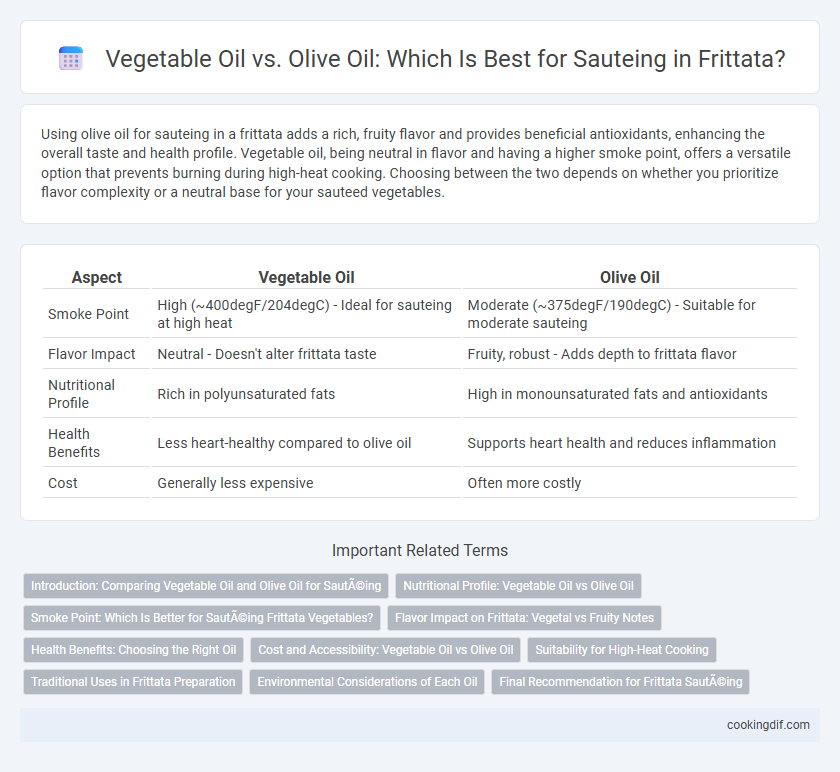Using olive oil for sauteing in a frittata adds a rich, fruity flavor and provides beneficial antioxidants, enhancing the overall taste and health profile. Vegetable oil, being neutral in flavor and having a higher smoke point, offers a versatile option that prevents burning during high-heat cooking. Choosing between the two depends on whether you prioritize flavor complexity or a neutral base for your sauteed vegetables.
Table of Comparison
| Aspect | Vegetable Oil | Olive Oil |
|---|---|---|
| Smoke Point | High (~400degF/204degC) - Ideal for sauteing at high heat | Moderate (~375degF/190degC) - Suitable for moderate sauteing |
| Flavor Impact | Neutral - Doesn't alter frittata taste | Fruity, robust - Adds depth to frittata flavor |
| Nutritional Profile | Rich in polyunsaturated fats | High in monounsaturated fats and antioxidants |
| Health Benefits | Less heart-healthy compared to olive oil | Supports heart health and reduces inflammation |
| Cost | Generally less expensive | Often more costly |
Introduction: Comparing Vegetable Oil and Olive Oil for Sautéing
Vegetable oil offers a neutral flavor and a high smoke point, making it ideal for sauteing vegetables in a frittata without overpowering other ingredients. Olive oil, rich in antioxidants and monounsaturated fats, contributes a distinctive, fruity taste while providing health benefits that enhance the nutritional profile of the dish. Selecting between vegetable oil and olive oil for sauteing depends on balancing flavor preferences and cooking temperature requirements to achieve the perfect frittata texture.
Nutritional Profile: Vegetable Oil vs Olive Oil
Olive oil contains high levels of monounsaturated fats and antioxidants such as vitamin E and polyphenols, which contribute to heart health and anti-inflammatory effects when used for sauteing in frittatas. Vegetable oil, often a blend of soybean, corn, or sunflower oils, typically has a higher proportion of polyunsaturated fats and omega-6 fatty acids, which in excess may promote inflammation. Choosing olive oil for sauteing vegetables in a frittata enhances the nutritional profile by providing beneficial fats and bioactive compounds that support overall wellness.
Smoke Point: Which Is Better for Sautéing Frittata Vegetables?
Olive oil, with a smoke point around 375degF (190degC), provides a flavorful option for sauteing vegetables in a frittata while maintaining its nutritional benefits. Vegetable oil typically has a higher smoke point, around 400-450degF (204-232degC), making it less likely to burn during high-heat cooking and ideal for quick sauteing. For sauteing vegetables in a frittata, choosing olive oil offers a balanced combination of taste and moderate heat tolerance, while vegetable oil excels in preventing smoke at higher temperatures.
Flavor Impact on Frittata: Vegetal vs Fruity Notes
Vegetable oil imparts a neutral, mild flavor to a frittata, allowing the natural ingredients to shine without altering the overall taste profile. Olive oil contributes fruity and slightly peppery notes, enhancing the depth and complexity of the frittata's flavor. Choosing between vegetable and olive oil affects the dish's aromatic character, with olive oil providing a richer, more pronounced taste experience.
Health Benefits: Choosing the Right Oil
Olive oil offers superior health benefits for sauteing in frittatas due to its high content of monounsaturated fats and antioxidants that support heart health and reduce inflammation. Vegetable oils, such as canola or sunflower oil, typically contain higher levels of polyunsaturated fats and omega-6 fatty acids, which can promote oxidative stress if consumed excessively. Selecting extra virgin olive oil enhances nutrient absorption and imparts a rich flavor, making it the ideal choice for preparing a healthy and flavorful frittata.
Cost and Accessibility: Vegetable Oil vs Olive Oil
Vegetable oil is generally more cost-effective and widely accessible than olive oil, making it a popular choice for sauteing in frittata preparation. Olive oil, while often pricier, offers superior flavor and is readily available in most grocery stores but may not fit tight budgets. Choosing between the two depends on prioritizing affordability and availability versus culinary quality.
Suitability for High-Heat Cooking
Olive oil, especially extra virgin, has a lower smoke point around 375degF (190degC), making it less ideal for high-heat sauteing compared to vegetable oil, which typically has a higher smoke point near 400-450degF (204-232degC). Vegetable oil's heat tolerance ensures even cooking without burning, preserving the flavor and texture of vegetables in a frittata. Using vegetable oil for sauteing vegetables in a frittata helps achieve optimal caramelization without the risk of harmful compounds forming from overheated olive oil.
Traditional Uses in Frittata Preparation
Traditional frittata recipes often favor olive oil over vegetable oil due to its rich flavor profile and Mediterranean heritage, enhancing the dish's authenticity and taste. Olive oil's moderate smoke point suits gentle sauteing of vegetables, ensuring a tender texture without bitterness. Vegetable oil, while more neutral, lacks the distinctive aroma that complements the egg and herb combination characteristic of classic frittatas.
Environmental Considerations of Each Oil
Olive oil production generally has a lower environmental impact compared to vegetable oil, as it requires less water and generates fewer greenhouse gas emissions during cultivation and processing. Vegetable oils like canola or soybean often involve large-scale monoculture farming, leading to deforestation, soil degradation, and higher pesticide use. Choosing olive oil for sauteing in a frittata not only enhances flavor but also supports more sustainable agricultural practices.
Final Recommendation for Frittata Sautéing
Olive oil is ideal for sauteing vegetables in a frittata due to its rich flavor and moderate smoke point, which enhances taste without compromising nutritional value. Vegetable oil, with a higher smoke point, can be used for faster cooking but lacks the depth of flavor that olive oil provides. For the best balance of flavor and health benefits, extra virgin olive oil is recommended.
Vegetable oil vs Olive oil for sautéing Infographic

 cookingdif.com
cookingdif.com